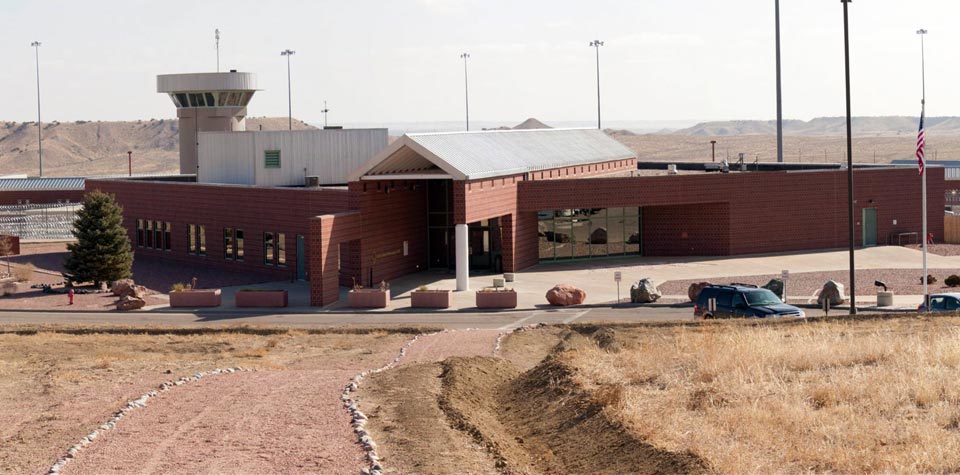

Off Colorado’s Highway 67, the U.S.’s highest-security “supermax” prison, ADX Florence sits in the shadow of the Rocky Mountains. The Federal Bureau of Prisons, which owns and operates the facility, opened the “control unit” in 1994 for male prisoners deemed unusually violent or likely to escape from other facilities.
The “Alcatraz of the Rockies,” as it’s informally known, is currently home to Dzhokhar Tsarnaev of the Boston Marathon Bombing; Theodore Kaczynski, better known as the Unabomber; double agents like Harold Nicholson, a CIA spy secretly working for the Soviets; mafiosos Joseph Lombardo and James Marcello; Ramzi Yousef, who planned the 1993 World Trade Center bombing; and Zacarias Moussaoui of the 9/11 conspiracy, just to name a few.
Now, Sinaloa cartel leader Joaquin “El Chapo” Guzman may join their ranks.
On Wednesday, a judge sentenced Guzman to life in prison plus 30 years for drug trafficking and money laundering. Authorities have not yet assigned Guzman to a prison. But given his history of escapes—most notably, he broke out of a Mexican maximum-security prison via a mile-long tunnel—experts speculate he’ll end up in ADX Florence.
But in a nation of 1,719 state prisons, 102 federal prisons, and countless other municipal, military, and immigrant detention facilities, what elevates ADX Florence above the rest?
It’s a matter of design.
Alcatraz may have been surrounded on all sides by the frigid waters of the San Francisco Bay, but ADX Florence “is literally built into the side of a mountain, with a robust security infrastructure,” Martin Horn, a criminal justice professor, told Reuters. 12 gun towers surround the compound. Razor wire, guard dogs, and laser beams secure the perimeter.
This sense of isolation and control extends inside the buildings. At all times, prisoners, guards, and other personnel are under surveillance. Every building is equipped with motion sensors; even floors have pressure sensors to track where people are walking. 1,400 remote-controlled doors control movement inside the building.
Each inmate is assigned their own 7-by-12 foot cell, where they spend roughly 23 hours alone each day. The cells (and everything in them, including the sink-toilet, shower, desk, and bed) are forged from concrete. It’s reportedly soundproof; that way, prisoners can’t communicate with others in their block by talking or tapping out codes. A slot in the door allows for meal delivery with little to no interaction between inmates and guards. Psychiatric evaluations, spiritual guidance, and other services are also provided through the door, or via telecommunication. A 2014 Amnesty International report on the facility found “that prisoners routinely go days with only a few words spoken to them.” The report was titled “Entombed—Isolation in the U.S. Prison System.”
One of the things that seems to haunt former ADX Florence inmates is the window design. Each cell reportedly has a 4-inch-wide window. The angled slit cuts through the thick prison walls in such a way that inhabitants can’t understand their own location in the complex. “You can’t see nothing, not a highway out in the distance, not the sky,” Travis Dusenbury, who spent 10 years in the prison’s general population, told The Marshall Project, a non-profit criminal justice newsroom. “You know the minute you get there you won’t see any of that, not for years and years.”
Prisoners spend no more than 10 hours outside their cells each week. Even then, they’re kept in isolation: the yard is sectioned off into a series of individual cages. Often, when an inmate is outside his cell, he’s restrained. These restraints can be severe, according to the Amnesty report, with an inmate’s feet and hands shackled and tied to a belt around his waist. Sometimes, a prisoner’s cuffed hands are further restrained inside a black box.
Lawyers, criminal justice advocates, investigators, former inmates, and even former employees agree: the space is made to detain people who are no longer considered fully human. “It’s not designed for rehabilitation,” a former ADX Florence warden told the New York Times Magazine. “Period. End of story.”







